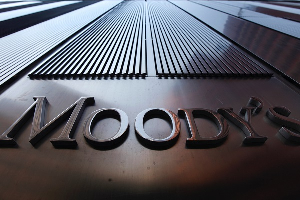Global credit ratings agency Moody's upgraded Ghana's long-term local and foreign currency issuer ratings to "Caa2" from "Caa3" and "Ca," respectively on Friday October 11, 2024.
The upgrade was based on extensive debt treatment that has significantly alleviated the government's financial burdens.
Subsequently, Moody's also revised Ghana's outlook from "stable" to "positive".
According to a statement from Moody's, it noted that the “positive outlook reflects the potential for liquidity risk to ease amid ongoing fiscal consolidation efforts supported by an IMF programme.”
Read the full statement below:
Moody's Ratings (Moody's) has on October 11, 2024 upgraded Government of Ghana's long term local and foreign currency issuer ratings to Caa2 from respectively Caa3 and Ca and changed the outlook to positive from stable.
The main driver of the upgrade to Caa2 is Ghana's extensive debt treatment that has provided meaningful relief to the government finances. Since seeking relief through the G20 common framework for debt treatment in 2022, the government of Ghana restructured local currency debt and debt owed to bilateral official-sector creditors and concluded the exchange of Eurobonds on 9 October rating.
Debt restructuring along with the debt service moratorium imposed during the negotiation period, has reduced the government debt burden from a peak of 93% of GDP in 2022 to an expected 81% in 2024.
However, going forward, the resumption of debt service payments, fiscal risks in the run-up to the December elections, potential negative pressure on the currency as well as reliance on expensive short-term debt represent still-elevated liquidity risk, constraining the rating.
The positive outlook reflects the potential for liquidity risk to ease amid ongoing fiscal consolidation efforts supported by an IMF programme. Should the risk factors mentioned above dissipate, Ghana's rating could migrate to a higher level.
Although Ghana's institutional credibility has weakened due to financial difficulties, the country's remaining institutional capacity offers potential for a relatively quick reversal in the credit trend. Moreover the programme with the IMF should help strengthen policy credibility and foster Ghana's access to low-cost funding from official-sector sources.
We have concurrently upgraded Ghana's local and foreign currency senior unsecured MTN program ratings to (P)Caa2 from respectively (P)Caa3 and (P)Ca, as well as assigning a Caa2 rating to the senior unsecured instruments issued as part of the debt exchanged on 9 October. No action was taken on outstanding debt instruments; we expect to withdraw those ratings when the obligations are no longer outstanding.
Concomitantly, we have revised up by one notch Ghana's local currency (LC) and foreign currency (FC) country ceilings to respectively B2 and B3, from B3 and Caa1, mirroring the upgrade of the sovereign local currency ratings by one notch. Non-diversifiable risks are captured in a LC ceiling three notches above the sovereign rating, taking into account relatively predictable institutions and government actions, limited domestic political risk, and low geopolitical risk; balanced against a large government footprint in the economy and the financial system and external imbalances.
The FC country ceiling one notch below the LC country ceiling reflects the authorities' history of providing access to foreign exchange, notwithstanding constraints on capital account openness and weak policy effectiveness.
RATINGS RATIONALE
RATIONALE FOR THE RATINGS UPGRADE to Caa2
Ghana's comprehensive debt restructuring provided meaningful relief to the government's financial burden, the primary reason for upgrading its ratings. Ghana's debt treatment, initiated in December 2022 under the Common Framework, has covered 55% of the total debt outstanding at that time. A 37% haircut on principal was applied to most eurobonds, representing 20% of total debt.
The remainder, composed of local currency debt (excluding Treasury Bills) and debt owed to bilateral official-sector creditors, was restructured earlier through a combination of lengthening of maturities and lowering of coupon rates. To support financial stability, the government used a Financial Stability Fund to support domestic financial institutions participating in the exchange.
Debt restructuring along with the debt service moratorium imposed during the negotiation period, has reduced government debt to an expected 81% of GDP in 2024 from 87% in 2023 and 93% in 2022. We expect government debt will continue to decline, albeit at a more gradual pace as the government resumes paying interest and principal on all its debts. Moreover, foreign exchange risk remains significant with close to half of the government debt denominated in foreign currency.
A key tenet of the fiscal outlook is the extent to which the government can maintain its fiscal consolidation efforts, ultimately supporting its access to funding. Given the elections planned for December 2024, the risk of fiscal arrears accumulating remains present. Assuming that there are no significant arrears, we forecast a balanced primary budget in 2024 and return to a primary surplus in 2025 close to the primary surplus of 1.3% of GDP achieved in 2023.
The government's main borrowing source remains the issuance of Treasury Bills at rates roughly in line with the central bank's policy rate of 27%, well-above the inflation rate of 21%. As a result, liquidity risk remains elevated, constraining the rating.
RATIONALE FOR THE POSITIVE OUTLOOK
The positive outlook reflects the potential for liquidity risk to ease amid ongoing fiscal consolidation efforts supported by an IMF programme. Fiscal risks in the run-up to the December elections, the resumption of debt service payments as well as the reliance on expensive short-term debt and downward pressure one the currency represent still-elevated risk; were theses risks to dissipate, Ghana's rating could migrate to a higher level.
Gradual disinflation and fiscal improvements raise the prospect of a normalization in interest rates for local currency debt, the main source of borrowing for the government, which would temper Ghana's debt affordability challenge and ease liquidity risks. In addition, official-sector funding could strengthen amid Ghana's IMF programme, which combined with robust gold exports recently, contributes to the prospect of a relatively stable currency.
Although Ghana's institutional credibility has weakened through the recent default, the country's institutional capacity offers potential for a relatively quick reversal in the credit trend. Notwithstanding the challenge brought by the economic crisis and debt restructuring, the quality of the country's institutions still exceeds that of most of its rated peers.
The comparatively swift and transparent handling of the debt restructuring lends credibility to the authorities. Fiscal data for 2024 so far show that revenue and spending have performed better than in the years preceding the debt restructuring. More broadly, Ghana's ranking under the Worldwide Governance Indicators for policy effectiveness, the rule of law and the control of corruption remains relatively strong.
The programme with the IMF should help strengthen policy credibility and foster Ghana's access to low-cost funding from official-sector sources, alleviating liquidity risks constraining the rating.
ENVIRONMENTAL, SOCIAL, AND GOVERNANCE CONSIDERATIONS
Ghana's ESG (Environmental, Social, and Governance) Credit Impact Score of 5 reflects its high exposure to social risks and recently impaired institutional effectiveness. Resilience to environmental and social risks is weak, constrained by low wealth and still-high debt levels.
Ghana's credit profile is exposed to environmental risks, reflected in its E-3 issuer profile score. The importance of the agriculture sector exposes the economy to weather-related disruptions and the effects of climate change. The water-dependent cocoa sector is a large contributor to GDP, exports and employment, exposing the country's agricultural production to droughts. Ghana also lacks access to potable water in some areas.
Ghana's exposure to social risks (S-4 issuer profile score) is driven by limited access to quality housing and education, especially in rural areas. Risks related to health and safety and access to basic services are moderately negative. The government has tried to strengthen social safety nets but the scope for social policy is limited by small revenue, a large portion of which continues to be consumed by interest expenses despite the recent conclusion of debt restructuring.
The governance issuer profile score of G-5 reflects Ghana's moderately effective institutions offset by domestic revenue mobilisation challenges and significant constraints on fiscal policy effectiveness manifest in still very weak debt affordability. The authorities have undertaken some institutional reforms on the revenue and competitiveness front, which will invariably take time to produce results. Ultimately, the government's resort to restructuring its debt, which constituted a default under Moody's definition, to improve debt sustainability represents a sign of institutional weakness.
GDP per capita (PPP basis, US$): 6,972 (2023) (also known as Per Capita Income)
Real GDP growth (% change): 2.3% (2023) (also known as GDP Growth)
Inflation Rate (CPI, % change Dec/Dec): 23.2% (2023)
Gen. Gov. Financial Balance/GDP: -2.2% (2023) (also known as Fiscal Balance)
Current Account Balance/GDP: 1.8% (2023) (also known as External Balance)
External debt/GDP: 49.9% (2023)
Economic resiliency: b2
Default history: At least one default event (on bonds and/or loans) has been recorded since 1983.
On 10 October 2024, a rating committee was called to discuss the rating of the Ghana, Government of. The main points raised during the discussion were: Completion of debt restructuring under the G20 Common Framework, which culminated in an exchange of eurobonds on 9 October 2024.
FACTORS THAT COULD LEAD TO AN UPGRADE OR DOWNGRADE OF THE RATINGS
We would likely upgrade Ghana's ratings if the government continues to deliver on fiscal consolidation, maintaining a primary surplus, and securing improved funding access ultimately reducing liquidity risk. In such a scenario, the external profile of the country should continue to strengthen, supported by official-sector funding but also by gold exports and remittances inflows, engendering more stability in the currency. Ultimately, these developments would increase the likelihood that government debt reduction will continue over the medium term, supporting a higher rating level.
Conversely, we would likely change the outlook from positive to stable if the government struggles to access more affordable funding sources, both domestically and externally, implying that interest payments will continue to pressure budget spending and perpetuate liquidity risk. A realization in 2025 that the government accumulated significant arrears in 2024 amid the elections would counter fiscal consolidation efforts and erode policy credibility, likely generating further liquidity pressure.
The principal methodology used in these ratings was Sovereigns published in November 2022 and available at https://ratings.moodys.com/rmc-documents/395819. Alternatively, please see the Rating Methodologies page on https://ratings.moodys.com for a copy of this methodology.
The weighting of all rating factors is described in the methodology used in this credit rating action, if applicable.
MA
Watch the latest edition of BizTech below:
Ghana’s leading digital news platform, GhanaWeb, in conjunction with the Korle-Bu Teaching Hospital, is embarking on an aggressive campaign which is geared towards ensuring that parliament passes comprehensive legislation to guide organ harvesting, organ donation, and organ transplantation in the country.
Click here to follow the GhanaWeb Business WhatsApp channel
General News of Sunday, 13 October 2024
Source: www.ghanaweb.com

















